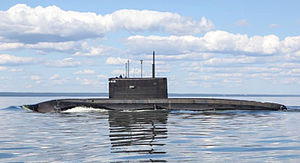 Russian Black Sea Fleet Improved Kilo–class submarine B-265 Krasnodar in 2015
| |
| Class overview | |
|---|---|
| Builders | |
| Operators | See Operators |
| Preceded by | Tango class |
| Succeeded by | Lada class |
| Subclasses | Sindhughosh class |
| Built | 1980–present |
| In service | 1980–present |
| In commission | December 1980–present |
| Building | 2 |
| Completed | 83 |
| Active | 65 |
| Lost | 1 |
| Retired | 16 |
| Preserved | 1 |
| General characteristics | |
| Type | Attack submarine |
| Displacement | |
| Length | 58.7–83.8 m (192 ft 7 in – 274 ft 11 in) |
| Beam | 9.9 m (32 ft 6 in) |
| Draft | 6.2 m (20 ft 4 in) |
| Installed power | Diesel-electric |
| Propulsion |
|
| Speed |
|
| Range |
|
| Endurance | 45 days |
| Test depth |
|
| Complement | 52 |
| Armament |
|


The Kilo-class submarines are a group of diesel-electric attack submarines designed by the Rubin Design Bureau[1][3][4] in the Soviet Union in the 1970s and built originally for the Soviet Navy.
The first version had the Soviet designation Project 877 Paltus (Russian: Па́лтус, meaning "halibut"), NATO reporting name Kilo.[5] They entered operational service in 1980 and continued being built until the mid-1990s, when production switched to the more advanced Project 636 Varshavyanka variant, also known in the West as the Improved Kilo class.[6][7][8] The design was updated again by the Russian Navy in the mid-2010s, to a variant called Project 636.3, also known as Improved Kilo II.[5]
- ^ a b Gady, Franz-Stefan (7 October 2019). "New Russian Attack Sub Enters Sea Trials". The Diplomat.
- ^ https://pp.userapi.com/c639327/v639327924/38091/NS2cZmDNPqM.jpg
- ^ a b "АПЛ Проекта 636.3" [Project 636.3 Nuclear Submarine]. pp.userapi.com (in Russian). Archived from the original on 30 August 2017. Retrieved 30 August 2017.
- ^ Cite error: The named reference
diplomat20191122was invoked but never defined (see the help page). - ^ a b Tomasz Grotnik (14 October 2024). "Russia launches Final Project 636.3 Submarine for Pacific Fleet". Naval News.
- ^ Gardiner, Chumbley and Budzbon (1995), pp. 408-409.
- ^ "Algeria Navy may receive 2 new Russian Improved Kilo-class submarines". Army Recognition. 8 August 2023.
- ^ Darman (2004), p. 46.